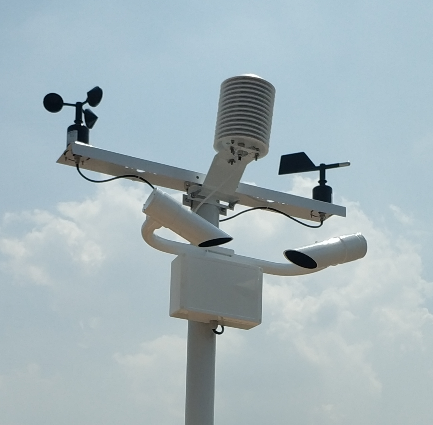In today's rapidly urbanizing world, managing traffic and ensuring public safety is more critical than ever. Traditional traffic management is often reactive, responding to incidents or congestion after they occur. The future of urban infrastructure, however, is a proactive, data-driven system. By transforming roads into intelligent networks, cities can predict and intervene before problems arise, creating a safer and more efficient environment for everyone.
At the heart of this transformation is a smart city sensor network, and specialized road sensors are on the front lines of this technology. The Coda Sensor suite provides the real-time insights needed for advanced road monitoring, often as a critical component of a larger Automatic Weather Station (AWS).

An intelligent road is a symphony of interconnected sensors, each a critical component in a larger system that constantly monitors its surroundings.
Road surface temperature and snow are two of the most immediate threats to road safety. The Infrared Road Surface Temperature Sensor provides instant, non-contact readings of the road's temperature, allowing authorities to anticipate the risk of black ice. This works in tandem with the Snow Depth Sensor, which accurately measures the thickness of snow accumulation. These data points are often fed directly into an Automatic Weather Station, which then correlates the information with other meteorological data like air temperature and humidity.
Use Case: On a frigid winter morning, a city's traffic management center receives an alert from sensors on a section of highway. The data shows the road surface temperature has dropped below freezing, and the snow depth is 1 cm. The integrated AWS and road sensor system immediately activates a digital message board warning of "Icy Roads, Reduce Speed" and dispatches the nearest fleet of salt trucks. The proactive treatment 20 minutes before a potential hazard helps prevent multiple chain-reaction accidents.
Beyond temperature and snow, road grip is crucial for safe driving. The Coda Sensor Friction Sensor provides a quantifiable value for road grip, while a Visibility Sensor detects adverse atmospheric conditions like fog and haze. These sensors are essential for real-time safety warnings and are often part of a comprehensive Automatic Weather Station system to provide a full picture of road and atmospheric conditions.
Use Case: On a winding mountain pass, Coda Sensor detects a sharp decrease in road friction due to a sudden downpour. Simultaneously, the Visibility Sensor reports that visibility has dropped below the safe threshold. The smart system immediately reduces the suggested speed limit for the section and alerts drivers via a traffic light before they enter the affected zone, significantly reducing accidents caused by slippery roads and low visibility.
A Rainfall Sensor measures not only the amount but also the intensity of rain, providing critical data for flood prevention. A Vehicle Radar accurately tracks traffic flow, speed, and vehicle count. The fusion of this data is a key advantage. For example, by correlating high rainfall intensity with slowing traffic speeds from the Vehicle Radar, the system can accurately identify flash flood conditions on the road.
Use Case: During a major storm, the Rainfall Sensor shows that precipitation intensity in a low-lying area has reached a critical level. The system, based on historical data, predicts the road will flood within 30 minutes and alerts the municipal department. By dynamically adjusting the traffic light timing based on Vehicle Radar data, the system improves traffic flow by 15% in the area, preventing gridlock.
A Noise Monitoring Sensor focuses on a city's environmental health. It measures ambient sound levels in real-time, providing valuable data for urban planning and improving resident quality of life. The data from these sensors, when integrated with other city-wide data sets, can help urban planners make informed decisions about infrastructure development.
Use Case: An urban planning department uses Noise Monitoring Sensor data collected from a major transportation hub to assess the impact of a new overpass on a nearby residential neighborhood. The data reveals that noise levels exceed acceptable limits during specific hours. The department then modifies the design of sound barriers and implements truck restrictions during the night, effectively improving the living environment for residents.
Through a complete smart city sensor network, the raw data collected by these devices is transformed into actionable intelligence. The Coda Sensor platform integrates these data streams into a single system, providing a holistic view of the urban environment. This allows cities to:
Optimize Traffic Flow: Using Vehicle Radar data, cities can optimize traffic light timings and dynamically adjust routes to bypass congested areas. The system can detect an unusual traffic buildup on a main artery and automatically reroute traffic from feeder roads to prevent a total standstill, improving overall traffic efficiency.
Reduce Accidents: A smart city sensor solution acts as an early warning system. By detecting a sudden drop in road surface temperature or a rapid increase in rainfall, the system can immediately alert drivers via digital signage or traffic apps. This real-time weather monitoring allows for proactive warnings that can lead to a 15% reduction in accidents.
Enable Predictive Maintenance: Instead of waiting for reports of potholes or clogged drains, cities can use road temperature and other sensor data to predict when and where infrastructure might fail. This allows maintenance to be scheduled during off-peak hours, saving money and minimizing traffic disruption.
By connecting infrastructure to a responsive network, cities can evolve from passively reacting to actively shaping a safer, more efficient, and healthier urban environment for all.
Learn how CODA Sensor solar radiation and PAR se
Discover how real-time weather station data impr
Discover how Automatic Weather Stations (AWS) ar
Contact: Molly
Phone: +86-17775769236
Tel: 86-0731-85117089
Email: molly@codasensor.com
Add: Building S5, Aux Square, Yuelu District, Changsha City, Hunan Province, China
We chat